It’s not the worst maritime disaster in world, or even Canadian history, but it certainly is among the most tragic.
Over 344 people waited for a day and half aboard the stricken SS Princess Sophia for help they could see nearby, but which could not rescue them. They waited desperately not knowing that within hours they would all be dead in the icy northern Pacific water.
The Princess Sophia was built in 1911, entering service in 1912 as one of several, passenger, mail and freight steamers built for the Canadian Pacific Steamshipo Line. They operated along the coast of British Columbia from Vancouver and Victoria up to Skagway, Alaska. These were coastal class ships known as “pocket liners” i.e. not the luxurious ocean liners, but smaller and nonetheless indicating a fair degree of comfort for passengers, especially in first class.
On October 23, the ship left Skagway Alaska close to midnight, and about 3 hours behind schedule.
Soon after leaving, the ship ran into a blinding snowstorm in the narrow Lynn Canal. Almost in the middle of the already narrow fjord was a rocky outcrop known as the Vanderbilt Reef. Hidden just below the surface at high tide, it is visible at low tide just above the surface.
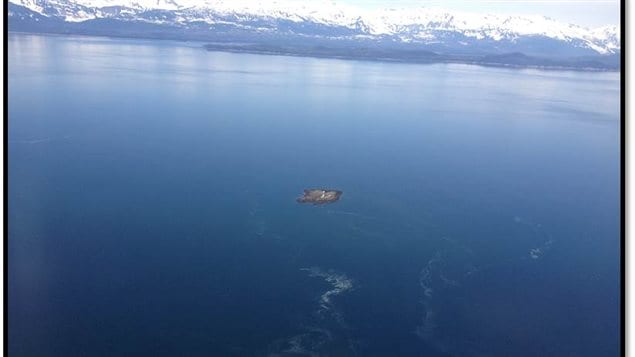
The ship channel is only a few km wide, and the reef made that passage even narrower, and a threat even in good weather.
The driving winds pushed the Sophia off course in the channel and drove it firmly onto the reef in the early hours of the 24th.
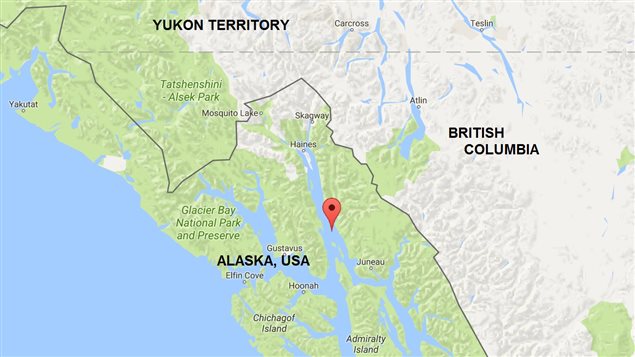
Initially the captain hoped high tide would free the sturdy ship, and with a wireless message sent, and rescue ships soon to be on their way, the situation did not look immediately life threatening.
But, at dawn high tide came and went and the ship remained stuck and pounded by wind and waves.
Rescue ships arrived but during the day could not remove the passengers due to the still rough conditions. Rescue boats risked being smashed themselves against the rocks as high waves alternately washed over and then exposed the rocky reef. (This was later deemed by an inquiry to have been the only time the passengers might have been removed)
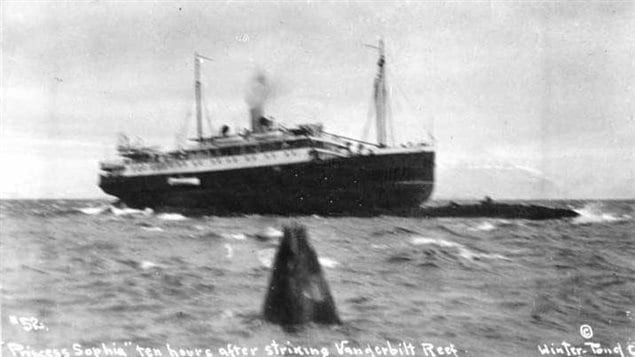
The captain was deceived by a faulty barometer indicating calmer weather was coming and told rescue ships to return to port and await the calmer weather the next morning.
One would-be rescuer who had approached the stricken liner in small boat noted a hole in the bow with water rushing in and out from the waves.

A number of rescue vessels remained close during the night but no rescue could be attempted . On the 25th conditions began to worsen and a morning attempt to bring an all-weather ship the lighthouse tender “Cedar” close in order to take off passengers failed against worsening conditions.
The rescuers again had to move to shelter as winds picked up to gale force. They were hoping that as Sophia had already remained high on the rocks through the previous rough weather, she would remain relatively safe for another night.
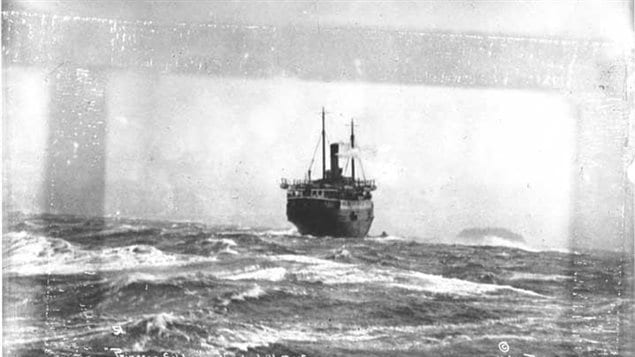
Although the ship sank in American waters, it is considered the worst maritime disaster in British Columbia
Around 16;44 the late afternoon a desperate wireless message from Sophia to Cedar said the ship was foundering and to hurry to the rescue. At 17:20 the last message from Sophia.
Cedar left its protected harbour and headed out towards Vanderbilt Reef. As soon as it cleared Sentinal Island’s shelter, it encounterd gale force winds, snow, and huge waves as darkness increased. Unable to see much beyond his ship’s own bow, the captain knew it too was in danger of striking the reef if and when it could find it. Reluctantly in the face of the situation, Cedar turned back, finding its own shelter with difficulty.
On the morning of the 26th, with slightly calmer winds, rescuers returned to the reef and were shocked to find the liner gone. Only the mast of Sophia was sticking out of the water, and of the 344 or more souls aboard, passengers and crew, there were no survivors.
With no survivors or witnesses, it is thought the gale force winds from the north pushed higher water onto the reef partially floating Sophia while pushing her stern around and dragging the bottom across the reef, ripping it open.
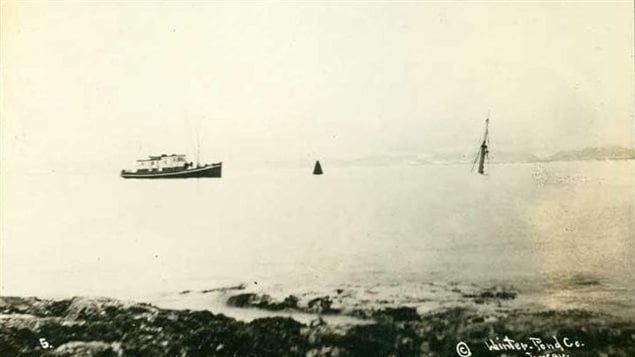
A subsequent inquiry ruled that some or all of the passengers might have been saved in a brief window on the 24th before the winds picked up, but that the Captain had ruled against it, presumably fooled by the faulty barometer and hopes the weather would calm.
The grim task of recovering bodies went on for weeks as divers found many still in their cabins, while others washed up on the shores around the channel.
Although the ship sank in American waters, it was a Canadian ship and carried many passengers from the Yukon, so is considered the worst maritime disaster in Alaskan , Yukon, and British Columbia history.
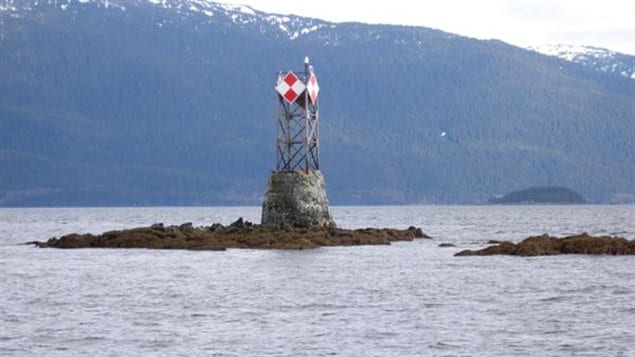
In spite of that, the event is little remembered, as the disaster occurred close to the November 11th Armistice ending the First World War which quickly pushed news of the sinking out of popular memory.
Many wrote letters in the final hours of the ship, one of them was by John R. “Jack” Maskell, found on his body, and reprinted in papers of the day.
Shipwrecked off coast of Alaska
S.S. Princess Sophia
October 24, 1918
My own dear sweetheart,
I am writing this my dear girl while the boat is in grave danger. We struck a rock last night which threw many from their berths, women rushed out in their night attire, some were crying, some too weak to move, but the lifeboats were swung out in all readiness but owing to the storm would be madness to launch until there was no hope for the ship. Surrounding ships were notified by wireless and in three hours the first steamer came, but cannot get near owing to the storm raging and the reef which we are on. There are now seven ships near. When the tide went down, two-thirds of the boat was high and dry. We are expecting the lights to go out at any minute, also the fires. The boat might go to pieces, for the force of the waves are terrible, making awful noises on the side of the boat, which has quite a list to port. No one is allowed to sleep, but believe me dear Dorrie it might have been much worse. Just hear there is a big steamer coming. We struck the reef in a terrible snowstorm. There is a big buoy near marking the danger but the captain was to port instead [of] to starboard of [the] buoy. I made my will this morning, leaving everything to you, my own true love and I want you to give £100 to my dear Mother, £100 to my dear Dad, £100 to dear wee Jack, and the balance of my estate (about £300) to you, Dorrie dear. The Eagle Lodge will take care of my remains.
In danger at Sea.
Princess Sophia
24th October 1918
To whom it may concern:
Should anything happen [to] me notify, notify Eagle Lodge, Dawson. My insurance, finances, and property, I leave to my wife (who was to be) Miss Dorothy Burgess, 37 Smart St., Longsight, Manchester, England
additional information- sources
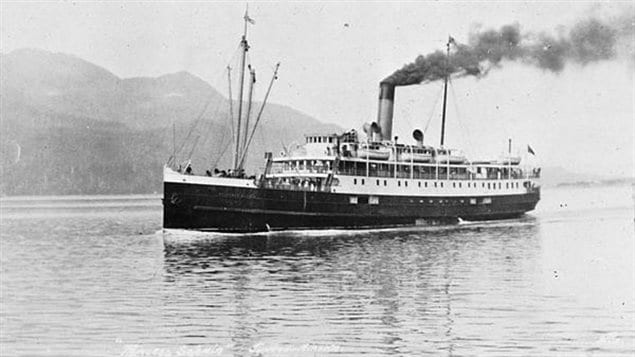






For reasons beyond our control, and for an undetermined period of time, our comment section is now closed. However, our social networks remain open to your contributions.